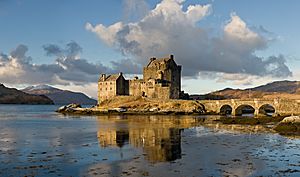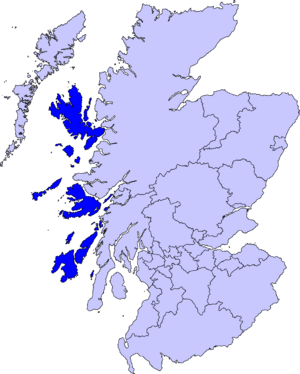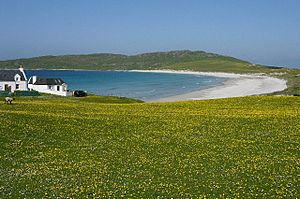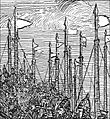Inner Hebrides facts for kids


The Inner Hebrides are a group of islands located off the west coast of Scotland. They are found to the southeast of another island group called the Outer Hebrides. Both of these island chains together are known as the Hebrides.
These islands have a mild ocean climate. This is because the Gulf Stream, a warm ocean current, flows past them. This current brings warmer water and air, making the weather less extreme than you might expect for islands so far north.
There are 36 islands in the Inner Hebrides where people live. There are also 43 more islands that are not lived on, but are larger than 30 hectares (about 74 acres). The main ways people make a living here are through tourism, crofting (a type of small-scale farming), fishing, and making whisky.
All the islands together cover an area of about 4,158 square kilometers (1,605 square miles). In 2001, about 18,257 people lived there. This means there were only about 4 people per square kilometer (11 people per square mile).
The islands have many important old structures from prehistoric times. These were built long before the ancient Roman and Greek writers first wrote about the islands.
In the past, the first known people to settle here were the Picts in the north and the Gaels in the south. Later, the islands became part of the Kingdom of Mann and the Isles, which was a kingdom ruled by the Norse (Vikings). The Norse ruled for over 400 years. In 1266, control of the islands was given to Scotland through the Treaty of Perth.
After this, different clan chiefs took control of the islands. The most important clans were the Clan MacLeod and Clan MacDonald. In the 1800s, many communities were badly affected by the Highland Clearances. This was a time when many people were forced to leave their homes. It is only recently that the number of people living on the islands has stopped going down.
Getting around by sea is very important for the Inner Hebrides. Ferry services connect the islands to each other and to mainland Britain. The Gaelic language is still spoken by many people in some areas. Also, the Wee Free Church of Scotland is still strong in certain parts. The beautiful landscapes of the islands have inspired many artists. The islands are also home to a wide variety of wildlife.
Contents
Islands of the Inner Hebrides
The Inner Hebrides are made up of many islands, both big and small. Some of the well-known islands include:
The largest islands in the group are Skye, Mull, and Islay.
There are also many smaller islands where no one lives. One of these uninhabited islands is Staffa. Staffa is famous for Fingal's Cave and its amazing columns of basalt rock. These columns look like giant organ pipes.
History of the Islands
The Inner Hebrides have a long and interesting history. People have lived on these islands for thousands of years.
Early Settlers and Ancient Times
Before written history, people built many important structures on the islands. These include ancient forts and burial sites. The first groups of people we know about were the Picts in the northern islands and the Gaels in the south.
Later, the islands were mentioned by ancient Roman and Greek writers. However, the structures built by the early inhabitants are much older than these writings.
Viking Rule and Scottish Control
Around the 9th century, the Norse people, often called Vikings, came to the Hebrides. They ruled the islands for over 400 years as part of their "Kingdom of Mann and the Isles." This kingdom was known as Suðreyjar, which means "Southern Isles."
In 1266, the Norse rule ended. The islands were officially given to Scotland through an agreement called the Treaty of Perth. This was a big change for the islands, bringing them under Scottish control.
Clan Chiefs and Modern Changes
After the islands became part of Scotland, different powerful clans took charge. The Clan MacLeod and Clan MacDonald were two of the most important ruling families. They had a lot of influence over the people and the land.
In the 19th century, a difficult period known as the Highland Clearances happened. During this time, many people were forced to leave their homes and farms to make way for sheep farming. This had a very sad and damaging effect on many communities in the Inner Hebrides. For a long time, the number of people living on the islands kept going down. Luckily, in recent years, this decline has stopped, and some communities are growing again.
Life and Culture
Life in the Inner Hebrides is closely connected to the sea and the land. The culture here is rich with history and traditions.
Language and Religion
The Gaelic language is an important part of the culture in some areas of the Inner Hebrides. Many people still speak Gaelic, and efforts are made to keep the language alive.
The Wee Free Church of Scotland is also very important in some communities. It plays a central role in the lives of many islanders.
Transport and Economy
Because the Inner Hebrides are islands, sea transport is vital. Ferry services are like the main roads, connecting the islands to each other and to the Scottish mainland. These ferries carry people, goods, and vehicles.
The economy of the islands relies on a few key activities. Tourism is a big one, with many visitors coming to see the beautiful scenery and learn about the history. Crofting, which is a traditional way of farming small plots of land, is also important. Fishing provides food and jobs, and the islands are famous for their whisky distilling. Many well-known whisky distilleries are located here, especially on the island of Islay.
Nature and Inspiration
The stunning landscapes of the Inner Hebrides, with their rugged coastlines, green hills, and unique rock formations, have inspired many artists, writers, and musicians over the years.
The islands are also home to a diverse range of wildlife. You can find many different kinds of birds, including seabirds like puffins. Marine animals such as seals, dolphins, and even whales can be seen in the waters around the islands. The natural beauty and wildlife make the Inner Hebrides a special place.
Images for kids
-
Kinloch Castle, a historic building on Rùm.
-
Sgurr Alasdair, the highest mountain peak in the Inner Hebrides.
-
Laphroaig distillery, where famous whisky is made on Islay.
-
The ruins of Dun Ringill, an old fort near Elgol on the island of Skye.
-
The eighth-century St Martin's Cross on Iona, a very old stone cross.
-
Folio 32v of the Book of Kells, a famous old book that might have been made by monks on Iona.
-
A portrait of Flora MacDonald, a famous Scottish Jacobite, painted by Alan Ramsay.
-
Sea-filled slate quarries on Seil (in front) and Easdale in the Slate Islands.
-
The entrance to Fingal's Cave on Staffa.
-
An adult Atlantic puffin (Fratercula arctica) in its breeding colors on Lunga in the Treshnish Isles.
See also
 In Spanish: Islas Hébridas Interiores para niños
In Spanish: Islas Hébridas Interiores para niños



















